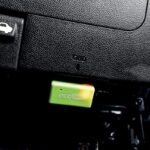Are you looking to understand what’s happening under the hood of your car in real-time? Do you want to decipher those cryptic check engine lights without a trip to the mechanic? A Bluetooth Mini Obd2 scanner might just be the tool you need. This compact and powerful device, when paired with your smartphone and the right app like Car Scanner, opens up a world of vehicle diagnostics, performance data, and much more.
At its core, a bluetooth mini OBD2 scanner is your personal vehicle health monitor. It plugs into your car’s OBD2 port – a standard port found in most vehicles manufactured after 1996 – and communicates wirelessly with your smartphone or tablet via Bluetooth. This connection allows you to access a wealth of information directly from your car’s engine management system (ECU). Forget bulky, expensive diagnostic tools; these mini scanners put professional-level diagnostics in the palm of your hand.
One of the primary uses of a bluetooth mini OBD2 scanner is reading and resetting Diagnostic Trouble Codes (DTCs). When your car’s check engine light illuminates, it’s signaling a problem, and the ECU stores a corresponding DTC. Using a bluetooth mini OBD2 scanner and an app like Car Scanner, you can instantly identify the meaning behind these codes. Car Scanner, for example, boasts an extensive database of DTC descriptions, helping you understand the issue at hand and even clear minor codes yourself.
Beyond just fault codes, a bluetooth mini OBD2 scanner paired with Car Scanner transforms your mobile device into a customizable dashboard displaying real-time vehicle performance data. Imagine monitoring engine temperature, RPM, speed, fuel consumption, and sensor readings all on your phone. You can tailor the display to show the gauges and charts that are most important to you. Furthermore, Car Scanner allows access to custom or extended PIDs (Parameter IDs), unlocking manufacturer-hidden data for deeper insights into your vehicle’s operation.
For car enthusiasts and DIY mechanics, the capabilities extend even further. Mode 06 testing, accessible through Car Scanner and a bluetooth mini OBD2 scanner, reveals ECU self-monitoring test results. This advanced feature can be invaluable for preventative maintenance and pinpointing potential issues before they escalate, saving on costly repairs down the line. Emission testing readiness checks are also simplified, ensuring your vehicle is compliant with regulations.
Car Scanner’s compatibility extends to a wide range of vehicles adhering to the OBD2 standard, generally vehicles built from 2000 onwards, and sometimes as far back as 1996. The app also boasts enhanced connection profiles for numerous car brands, including Toyota, BMW, Nissan, and Volkswagen, unlocking brand-specific features and deeper diagnostics. Features like Heads-Up Display (HUD) projection onto your windshield and accurate acceleration measurements (0-60 mph) further enhance the user experience, making Car Scanner a versatile tool for both diagnostics and performance monitoring.
When selecting a bluetooth mini OBD2 scanner, it’s crucial to choose a reliable adapter. While inexpensive clones are available, they can often be plagued with connectivity issues and may even negatively impact your car’s ECU. Reputable brands like Kiwi 3, Viecar, and Veepeak are recommended for their consistent performance and reliability. Ensure your adapter is ELM327 compatible and ideally Bluetooth 4.0 (Bluetooth LE) for optimal communication with your smartphone and the Car Scanner app.
In conclusion, a bluetooth mini OBD2 scanner is a powerful and affordable tool for any car owner wanting to understand their vehicle better. Paired with a feature-rich app like Car Scanner, it empowers you with real-time diagnostics, performance insights, and preventative maintenance capabilities, all from the convenience of your smartphone. Unlock your car’s secrets and take control of your vehicle’s health with a bluetooth mini OBD2 scanner today.
